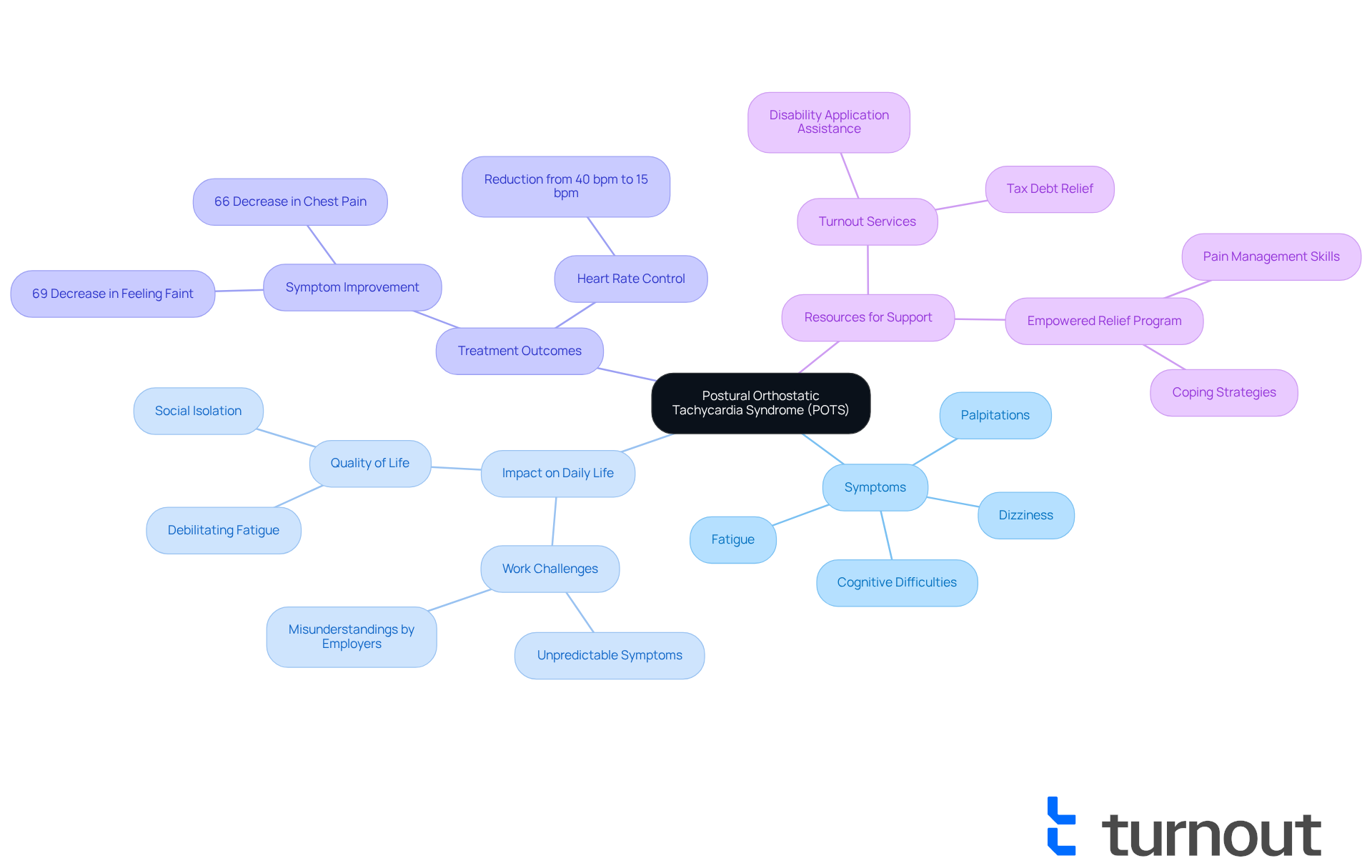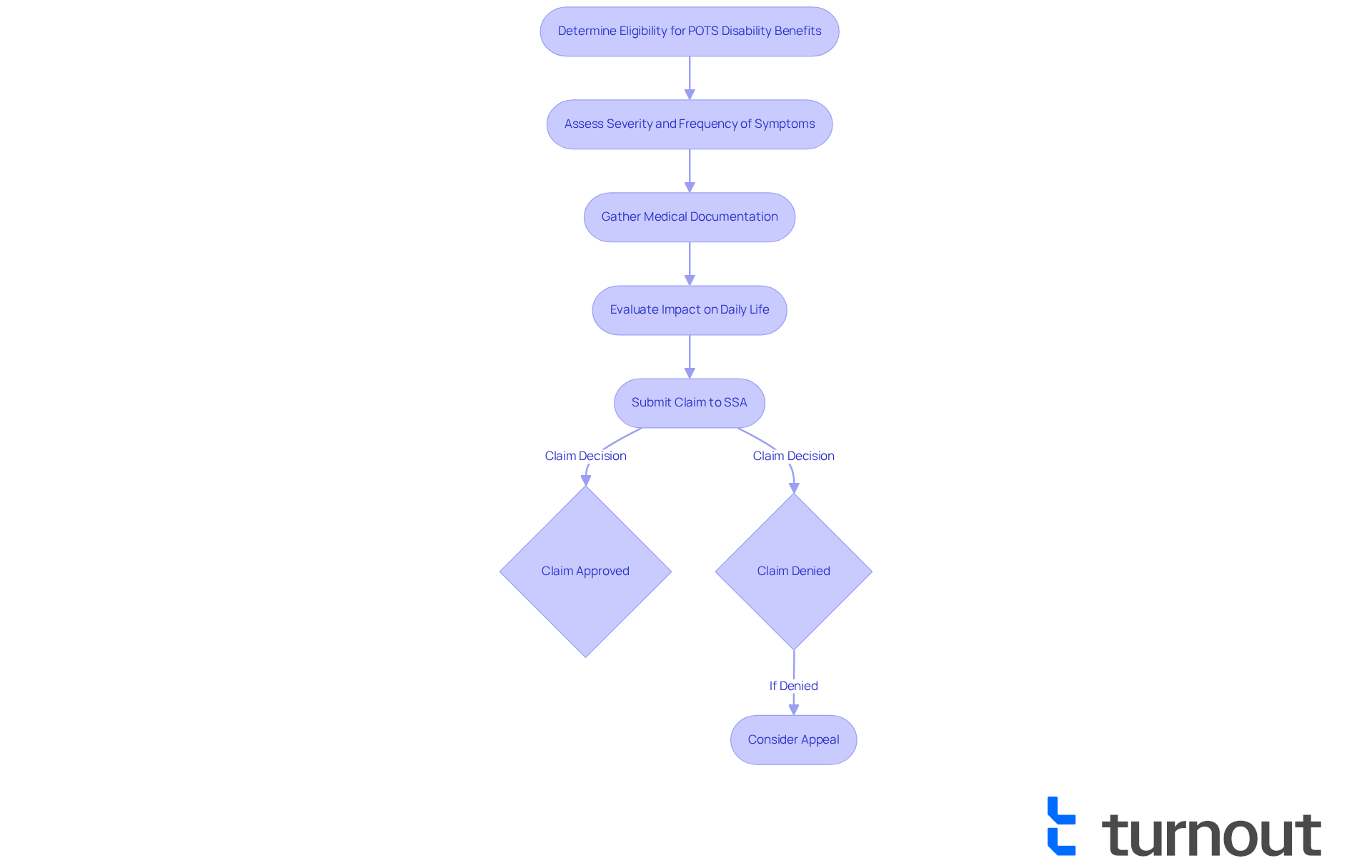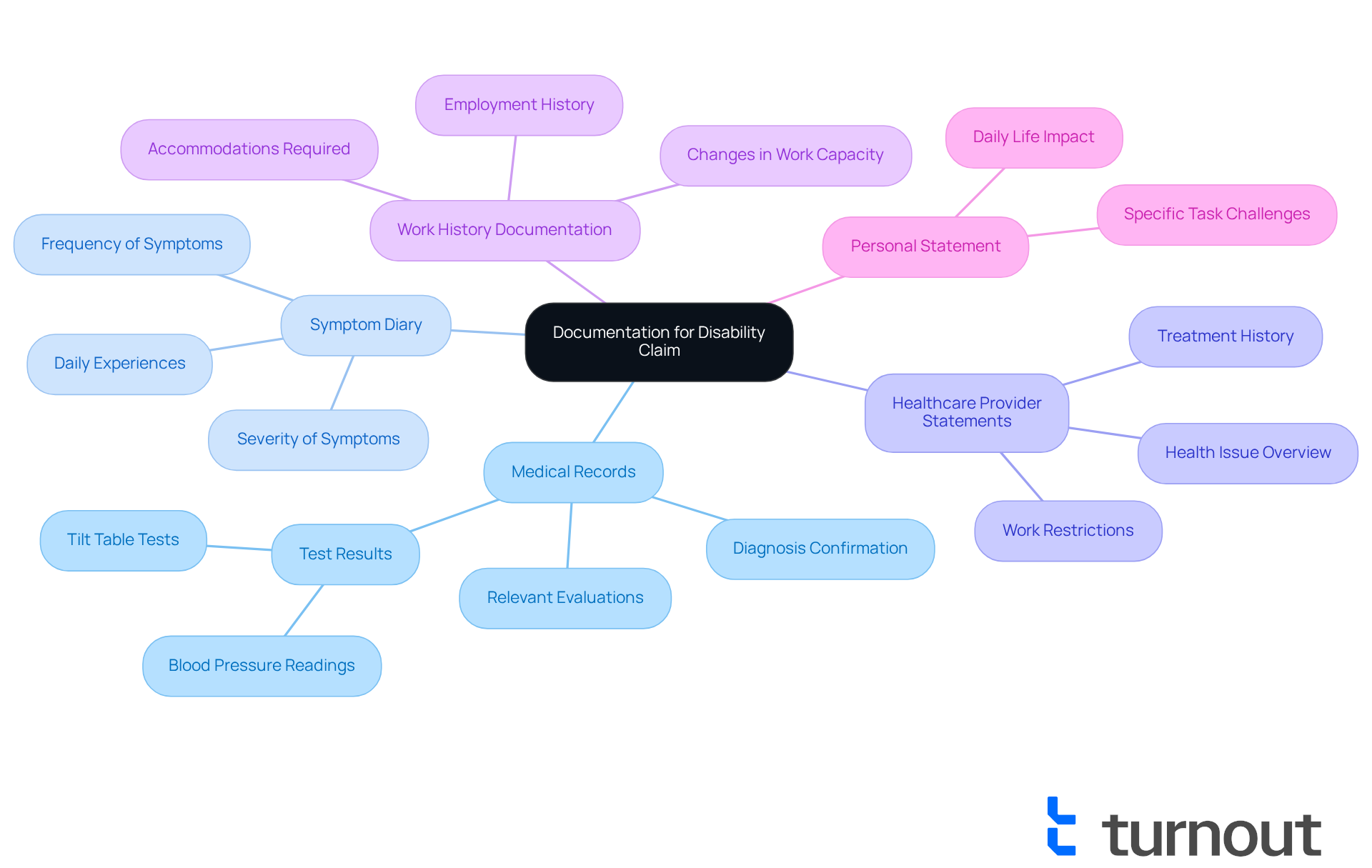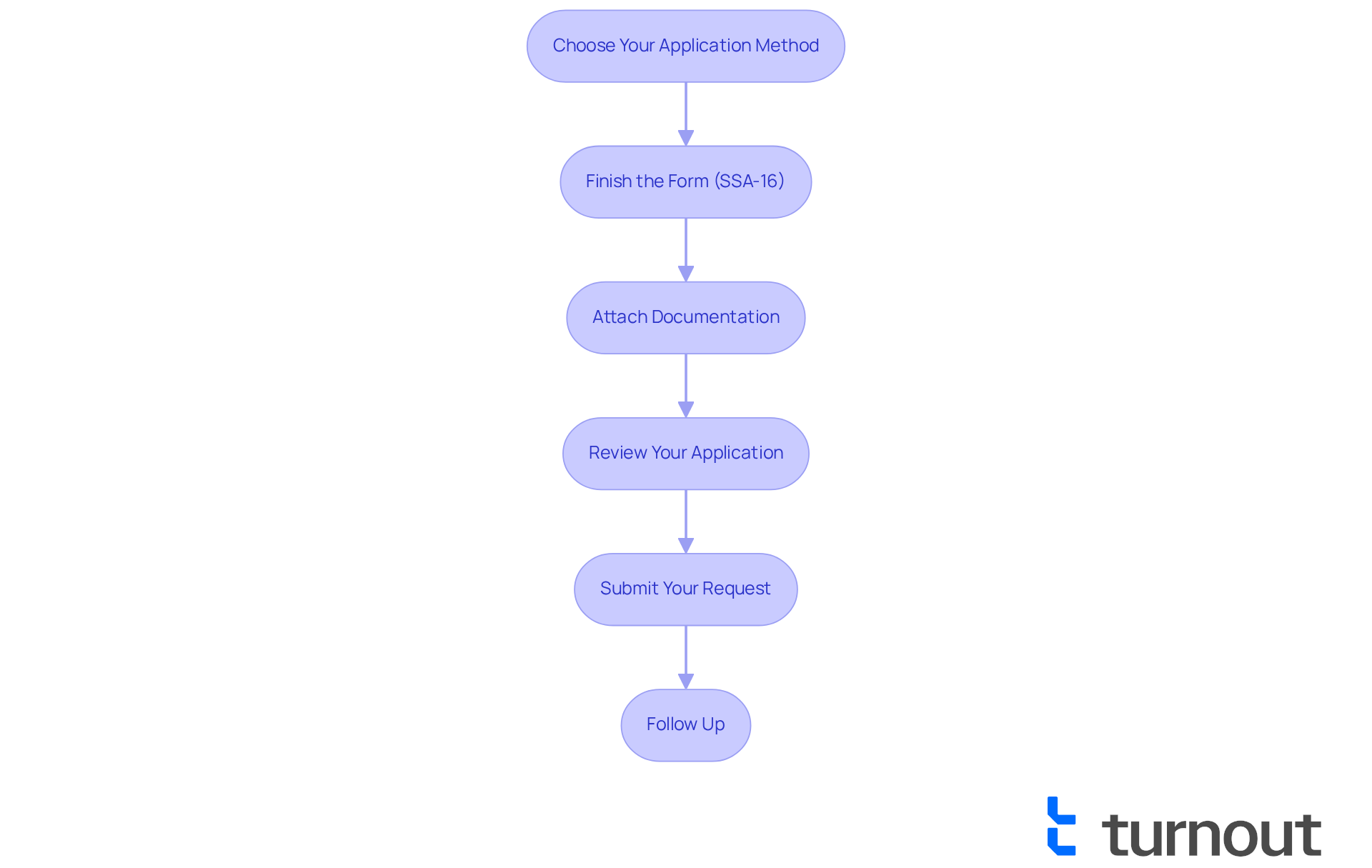Overview
The article titled "Navigate Disability for POTS: Your Step-by-Step Application Guide" serves as a compassionate resource for individuals living with Postural Orthostatic Tachycardia Syndrome (POTS) who are seeking disability benefits. We understand that navigating this process can feel overwhelming, and this guide is designed to support you every step of the way.
It highlights the importance of thorough documentation and a clear understanding of the eligibility criteria set by the Social Security Administration (SSA). You are not alone in this journey; many have faced similar challenges and found success with the right information and support.
This guide also offers valuable resources and encouragement to help you navigate the complex application process with confidence. Remember, taking the first step is crucial, and we’re here to help you through it.
Introduction
Navigating the complexities of disability applications can feel overwhelming, especially for those living with Postural Orthostatic Tachycardia Syndrome (POTS). This condition brings debilitating symptoms like dizziness and fatigue, which can significantly impact daily activities and work capacity.
We understand that communicating these challenges effectively is crucial for securing the necessary support and benefits. What steps can you take to ensure your application is thorough and compelling enough to overcome the barriers often faced in the disability claims process?
You're not alone in this journey, and we're here to help you find the way forward.
Understand Postural Orthostatic Tachycardia Syndrome (POTS)
Postural Orthostatic Tachycardia Syndrome (POTS) can be a challenging condition, affecting your daily life in significant ways. It’s characterized by an excessive increase in heart rate when moving from lying down to standing up. Many people experience symptoms like dizziness, lightheadedness, fatigue, and palpitations. We understand that these symptoms can hinder your ability to perform daily activities and work.
Living with POTS often means facing debilitating fatigue and cognitive difficulties, which can greatly impact your quality of life. A recent study showed that after treatment, participants reported a 69% decrease in feeling faint and a 66% decrease in chest pain. This highlights the potential for improved daily functioning with the right care.
It’s crucial to understand how POTS affects you personally, especially when explaining your situation in a disability for POTS request. Many patients encounter significant challenges in their work capacity due to the unpredictable nature of their symptoms. This often leads to misunderstandings about their condition.
As awareness of POTS grows, particularly following COVID-19, it’s essential to express these difficulties clearly in your submission. This will help ensure you receive the assistance you need. Turnout provides access to resources and services to support you through the complexities of the SSD submission process. Their trained non-professional advocates understand the nuances of your situation.
Additionally, for tax debt relief, Turnout collaborates with IRS-licensed enrolled agents. Customized, multi-dimensional care strategies can significantly enhance the quality of life for those managing POTS, offering hope and guidance as you navigate the disability for POTS applications. Remember, you are not alone in this journey, and we’re here to help you find the support you need.

Determine Eligibility Criteria for POTS Disability Benefits
If you are facing challenges due to Postural Orthostatic Tachycardia Syndrome (POTS), it’s important to know that you can qualify for disability benefits. To do so, you must show that your condition significantly limits your ability to work. The Social Security Administration (SSA) defines disability as the inability to engage in substantial gainful activity (SGA) due to a medically determinable impairment expected to last more than 12 months.
We understand that navigating this process can feel overwhelming. The SSA assesses claims based on the intensity of symptoms and their impact on your daily life. You will need to demonstrate that your condition prevents you from participating in SGA for at least 12 months. Key factors in this assessment include:
- The frequency and severity of your symptoms
- Comprehensive medical documentation
- How these issues affect your work-related tasks
A history of significant medical care or hospitalization related to POTS can strengthen your case. Many individuals have successfully secured disability benefits by providing detailed evidence of how their condition impacts their daily lives. This includes results from diagnostic tests and assessments that illustrate the severity of their symptoms.
Recent statistics show that a significant percentage of claims related to POTS have been approved. This highlights the importance of thorough documentation and a well-prepared application. Remember, you are not alone in this journey. Turnout is here to assist you in navigating this complex process. We connect you with trained nonlawyer advocates who can help you prepare your SSD claim without the need for legal representation.
Additionally, we offer tools and services to help you understand your financial assistance options, including tax debt relief. It's common to feel uncertain about the next steps, but with the right support, you can move forward confidently. The difficulties faced by individuals with POTS in obtaining benefits emphasize the necessity of providing thorough evidence to support your claims. We're here to help you every step of the way.

Gather Necessary Documentation for Your Claim
When seeking disability for POTS, gathering comprehensive documentation is crucial. We understand that this process can feel overwhelming, but you're not alone in this journey. Here are the key documents you will need:
-
Medical Records: Obtain detailed medical records from your healthcare providers confirming your POTS diagnosis. This should include results from tests such as tilt table tests, blood pressure readings, and other relevant evaluations that demonstrate the severity of your condition.
-
Symptom Diary: Maintain a symptom diary to log your daily experiences, noting the frequency and severity of symptoms. This record can effectively illustrate how the disability for POTS affects your daily life and ability to work, providing a clear picture of your challenges.
-
Healthcare Provider Statements: Obtain letters from your healthcare providers that outline your health issue, treatment history, and the restrictions it imposes on your work-related tasks. These statements can significantly bolster your claim by providing professional insights into your situation.
-
Work History Documentation: Document your work history, including any accommodations you required or changes in your work capacity due to your condition. This information helps establish the impact of your condition on your employment.
-
Personal Statement: Write a personal statement that describes how POTS affects your daily life. Include specific examples of tasks you find challenging because of your condition, as this narrative can provide compelling evidence to support your claim.
The importance of maintaining organized medical documentation and symptom diaries cannot be overstated. These records not only support your claim but also help in tracking the progression of your condition, which is vital for demonstrating its impact on your daily functioning related to disability for POTS. By submitting a comprehensive set of documents, you improve your likelihood of a favorable result. Moreover, Turnout offers access to skilled non-legal advocates who can help you navigate the SSD claims process, ensuring you comprehend the essential steps and have the assistance you require during your submission.

Submit Your Disability Application for POTS
Once you have gathered all necessary documentation, we understand that submitting your application for disability for POTS can feel overwhelming. Here are some steps to guide you through the process:
- Choose Your Application Method: You can apply online through the SSA website, by phone, or in person at your local SSA office. Many find that online submissions are quicker and more effective, which can ease some of the stress.
- Finish the Form: Take your time to fill out the form (SSA-16) carefully. Ensure that all information is accurate and thorough. Remember to include all pertinent medical conditions and indications, as this will support your application.
- Attach Documentation: It’s crucial to include copies of your medical records, symptom diary, doctor's statements, and any other supporting documents with your submission. The SSA needs these records to accurately determine your eligibility, so don’t overlook this step.
- Review Your Application: Before you submit, double-check all information for accuracy and completeness. Missing information can lead to delays or denials, which is a common concern for applicants.
- Submit Your Request: Once everything is in order, submit your request through your chosen method. If applying online, follow the prompts carefully to ensure successful submission. If you choose to submit by mail, consider using certified mail to track your request.
- Follow Up: After submission, keep an eye on the status of your request. You can check online or contact the SSA for updates. Be prepared to provide additional information if requested. Many successful applicants emphasize the importance of staying proactive during this stage.
Additionally, consider using the Disability Starter Kit. This resource is designed to help candidates prepare for their disability interview or online submission, offering vital details regarding necessary documents and the submission procedure.
It’s worth mentioning that the Compassionate Allowances list now encompasses 300 ailments, which has accelerated benefits for over 1.1 million individuals. This could enhance your chances of receiving quicker approvals for your POTS application by allowing for faster processing of claims related to disability for POTS. As one successful applicant stated, "Navigating the SSA process was daunting, but having the right resources made all the difference." Remember, you are not alone in this journey. Turnout is here to help you navigate these complex processes, utilizing trained nonlawyer advocates to support you in your SSD claims. We’re dedicated to ensuring you have the guidance needed to access the benefits you deserve.

Conclusion
Navigating the application process for disability benefits due to Postural Orthostatic Tachycardia Syndrome (POTS) can feel overwhelming. We understand that this journey is challenging, but knowing the intricacies of the condition and the necessary steps can empower you to seek the support you need. This guide highlights the importance of:
- Recognizing how POTS affects daily life
- Gathering comprehensive documentation
- Submitting a well-prepared application to enhance your chances of approval
Key insights discussed throughout this article include:
- The various symptoms of POTS
- The eligibility criteria for disability benefits
- The critical documentation needed to substantiate claims
From medical records and symptom diaries to healthcare provider statements, each component plays a vital role in illustrating the severity of your condition and its impact on your work capacity. Additionally, thorough preparation and proactive follow-up are essential, as these actions can significantly influence the outcome of your application.
Ultimately, you do not have to face the journey to secure disability benefits for POTS alone. With resources like Turnout and the support of trained advocates, you can navigate the complexities of the application process with greater confidence. By taking informed steps and ensuring all necessary documentation is in order, you can work towards obtaining the assistance you deserve. Together, we can improve your quality of life and facilitate a path toward better health and stability.
Frequently Asked Questions
What is Postural Orthostatic Tachycardia Syndrome (POTS)?
POTS is a condition characterized by an excessive increase in heart rate when moving from lying down to standing up, often accompanied by symptoms such as dizziness, lightheadedness, fatigue, and palpitations.
How does POTS affect daily life?
Living with POTS can lead to debilitating fatigue and cognitive difficulties, significantly impacting the quality of life and the ability to perform daily activities and work.
What improvements can treatment for POTS provide?
A recent study indicated that after treatment, participants reported a 69% decrease in feeling faint and a 66% decrease in chest pain, suggesting potential for improved daily functioning with appropriate care.
Why is it important to understand how POTS affects you personally?
Understanding your personal experience with POTS is crucial for explaining your situation in a disability request, as many patients face significant work capacity challenges due to the unpredictable nature of their symptoms.
How can I effectively communicate my POTS challenges in a disability request?
Clearly expressing the difficulties you face due to POTS in your submission is essential, especially as awareness of the condition grows, particularly following COVID-19.
What resources are available for individuals dealing with POTS?
Turnout provides access to resources and services to support individuals through the complexities of the Social Security Disability (SSD) submission process, including trained non-professional advocates who understand the nuances of the situation.
How does Turnout assist with tax debt relief for those with POTS?
Turnout collaborates with IRS-licensed enrolled agents to offer tax debt relief, providing customized care strategies that can enhance the quality of life for those managing POTS.
Is support available for individuals navigating the disability application process for POTS?
Yes, Turnout offers support and guidance for individuals navigating the disability application process, emphasizing that you are not alone in this journey.




